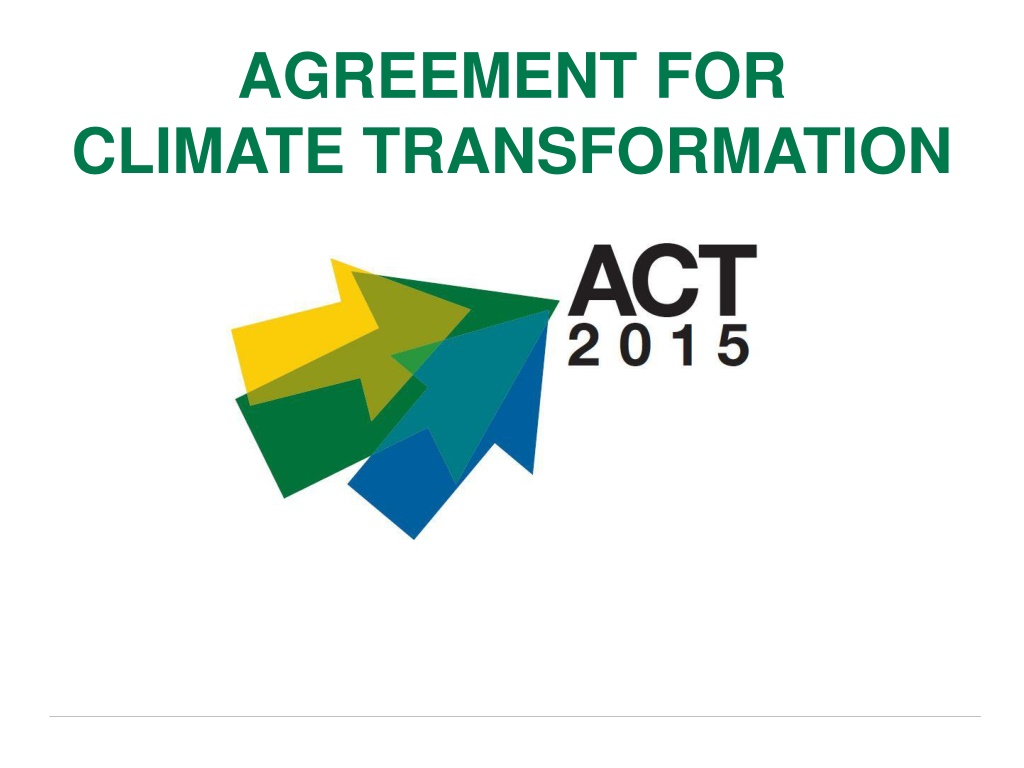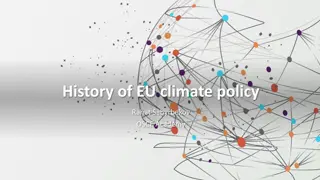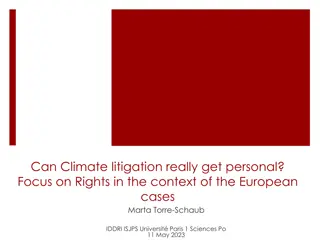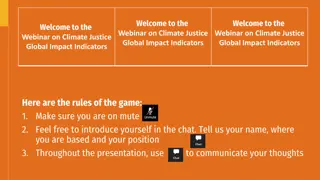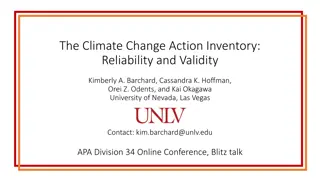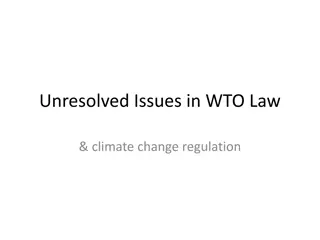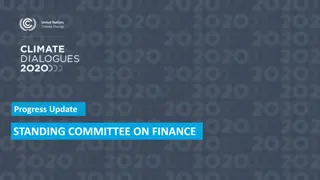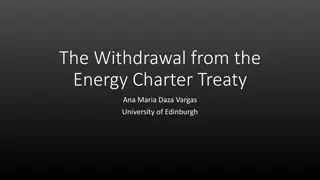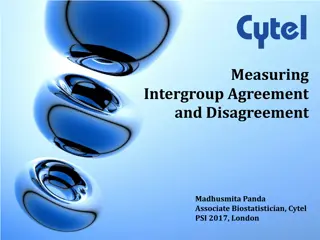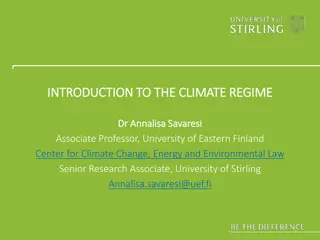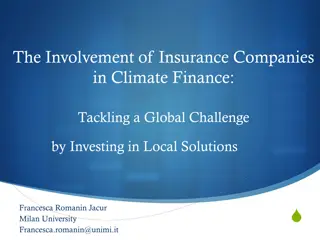Global Climate Transformation Agreement and Actions
Partners in the ACT 2015 initiative work towards climate transformation by aligning with the Paris Agreement's core functions to signal the inevitability of a low-carbon economy, drive global investment, and support vulnerable communities. The agreement emphasizes transparency, accountability, and equity through mitigation commitments, with a focus on supporting developing countries. The process involves regular updates, assessments by expert panels, and cooperation between parties through economic mechanisms. Choices on equity and mitigation post challenges on fairness and ambition to address climate change effectively. Join the movement for a sustainable future.
Download Presentation

Please find below an Image/Link to download the presentation.
The content on the website is provided AS IS for your information and personal use only. It may not be sold, licensed, or shared on other websites without obtaining consent from the author. Download presentation by click this link. If you encounter any issues during the download, it is possible that the publisher has removed the file from their server.
E N D
Presentation Transcript
AGREEMENT FOR CLIMATE TRANSFORMATION
ACT 2015 Partners: ACT 2015 is supported by:
PARIS AGREEMENTS SEVEN CORE FUNCTIONS 1. Send a clear signal that the low-carbon economy is inevitable 2. Connect the global agreement to the real economy and real people 3. Provide transparency and accountability 4. Accelerate investment in low-carbon, climate resilient economies 5. Build a basis for climate action that demonstrates fairness 6. Ensure the vulnerable have the capacity to build resilience and adapt 7. Link to science with a sense of urgency IMAGE: NASA
GLOBAL AGREEMENT The package: binding Agreement + decisions + political declaration
CHOICES ON EQUITY Then how to address equity? Formal process with set criteria? Equity framework No Yes Provision of support for developing countries Special LDCs/SIDS treatment Balance (3 cycles + L&D) Types of commitments, robustness and type of information based on capability
ELEMENTS OF MITIGATION (1) Parties shall prepare, regularly update, and implement mitigation commitments The ambition of all Parties mitigation commitments shall be raised in a continuous mitigation cycle every five years, informed by and informing the adaptation cycle and the support cycle Developing countries, including, in particular, least developed countries and small island developing States, shall be eligible for support Least developed countries and small island developing States shall have particular flexibility
ELEMENTS OF MITIGATION (2) Each Party may at any time submit mitigation commitments that are additional An independent expert panel is established to undertake individual and global assessments, which will be considered by the MOP Competent IO and NGOs, and sub-national authorities are encouraged to provide input Market and non-market mechanisms and new economic mechanism(s) allow for cooperation between Parties
CHOICES ON MITIGATION What s the long term goal of the cycle? Setting commitments? How to close the gap? Long-term goal Internationally negotiated Nationally determined Emission reduction target No roll-back + strengthen Phase out all greenhouse gas emissions to net zero Common accounting Ex ante assessment Global decarbonization 5 year cycle
ELEMENTS OF ADAPTATION (1) Shall prepare, regularly update and implement adaptation efforts statements The adaptation effort shall be enhanced, communicated and updated in a continuous adaptation cycle, informed by the mitigation cycle and the support cycle The MOP shall consider, every five years, ways to enhance adaption action The Adaptation Committee shall, upon submission of the adaptation efforts statements, every five years, undertake a review and submit a report
ELEMENTS OF ADAPTATION (2) Shall aim to ensure the allocation of public finance is balanced (equal allocation) Developing countries, including, in particular, least developed countries and small island developing States, shall be eligible for support Relevant international organizations and expert bodies outside the Convention are encouraged to cooperate and invited to report regularly on their actions and activities to achieve the long-term adaptation goal
CHOICES ON ADAPTATION Further Enhancement Goal or No Goal? Goal? Political Parity MRV (or M & E) 5-year cycle Qualitative Quantitative Effort statement Adaptation committee role NAPs undertaken for different temperature scenarios 50-50 finance split
CHOICES ON LOSS & DAMAGE Is Loss & Damage What is the vehicle? What are the functions? Goal or No Goal? Goal or No Goal? in the Agreement? Extend the WIM beyond 2016 Accelerate work under the WIM YES NO Additional research and scoping studies or pilots Compensation regime Specific requirements
ELEMENTS OF ADDITIONAL COOPERATIVE ACTION Parties may prepare, communicate and implement joint agreements to cooperate on actions that represent a progression These supplementary actions may include non-state actors Parties may work with other international organizations in pursuit of cooperative action Guidelines for recognition and contributions by subnational and non-State actors
SUPPORT CYCLE Finance Strategies Inputs: - National reports - Biennial assessments - Reports by financial Institutions - Equity Framework Synthesis of Finance Strategies by SCF Enhanced Action e.g. scaled up finance. Review and Consideratio n by the MOP GOAL: Support mitigation and adaptation goals and shift the agenda
ELEMENTS OF FINANCE (1) Parties shall shift and scale-up investments for low carbon and climate-resilient development Developed country Parties shall make financial contributions and mobilize finance at an increasing scale from a floor Other Parties, regularly determined by the MOP, shall also provide financial contributions Parties shall improve national policy and institutional frameworks for climate finance
ELEMENTS OF FINANCE (2) Every five years, until the LTGs are met, the provision of climate finance shall be scaled up as part of a continuous support cycle Each Party shall prepare and submit finance strategies Standing Committee on Finance shall prepare and provide, for the MOP a synthesis and aggregate analysis of the strategies Parties shall work with and through national and international financial institutions in order to align investment decisions and policies w the LTGs
CHOICES ON FINANCE Numbers in the Agreement? Credible pathway in the Agreement Support Cycle 5 yr cycles Finance Cycle Yes No Finance strategies Capacity building mechanism Standing committee Technology development and transfer More MRV Alignment of IFIs with climate objectives More Parties contribute in the future Replenishment of the GCF
CHOICES ON TECHNOLOGY Should we create a new TT mechanism? How do we enhance existing technology transfer? YES Create specific commitments for developed country Parties Set goals for all Parties in the Agreement NO What kind of goal? How to spend the funding? Increase diffusion of climate technologies Enhance national enabling environments What kind of goal? Increase public funding for R&D
CHOICES ON CAPACITY BUILDING Should we create a new CB mechanism? What should be its focus or function? YES Adequate and dedicated financial support Enhance institutional and legal framework Monitoring and review of efforts and support Provide advice and guidance NO How to spend the funding?
COMMONALITIES AND DIFFERENCES BETWEEN THE CYCLES What is different What is common Mitigation Adaptation Finance/Support 5-year cycle Submissions every 5 years Mitigation iNDCs/ Commitments Ex-ante assessment by Expert Panel Adaptation Efforts Statements Finance strategies (to include pathways and investment plans) Synthesis assessment by SCF MRV framework + additional Review or Assessment + Consideration by the MOP Review and recommendations by Adaptation Committee Assessment Process Consideration by the MOP in conjunction with technology & CB Reporting National Communications every 4 years National reports every 2 years NAPs, NAPAs (no frequency) National reports every 2 years
ELEMENTS OF TRANSPARENCY AND ACCOUNTABILITY (1) All Parties shall work towards improving transparency in a continuous and sustained manner over time, taking into account national capabilities and circumstances. No less than existing rules, methodologies and guidelines. Every two years each Party submits a national report including progress on implementation on mitigation and support More comprehensive report every four years, that includes information on adaptation efforts and plans Two-phased assessment Technical evaluation of individual reports Multilateral appraisal based on the output of the technical evaluation
ELEMENTS OF TRANSPARENCY AND ACCOUNTABILITY (2) Common Guidelines to be elaborated: Common global accounting framework that includes the land use sector and transferable emission units Common methodologies for risk, vulnerability assessments Common methodologies for tracking and reporting on financial flows
CHOICES ON TRANSPARENCY AND ACCOUNTABILITY How do you improve the system? Is the existing system sufficient? YES NO Adjust existing reporting obligations based on capabilities/ circumstances Same reporting obligations for all countries now All countries improve, but responsibilities and capabilities vary Enhanced MRV of actions and support How do you support developing countries? Provide financial and technical support Lower their requirements
MECHANISM FOR FACILITATING AND PROMOTING IMPLEMENTATION A mechanism to facilitate and promote implementation, including an implementation committee is established Non-adversarial and facilitative and shall aim at facilitating and promoting compliance Procedure triggered by Parties or through assessment process Shall be able to issue its finding independently & have effective measures available The MOP, at its first session, shall adopt further modalities and procedures
ELEMENTS OF LEGAL FORM The package: Binding Agreement + decisions + political declaration Within the Binding Agreement: Binding conduct linked to result (implementation of commitments), binding procedures (MRV) Tools for Robustness/Accountability: Transparency and Accountability Framework Compliance (facilitative mechanism)
CHOICES ON LEGAL FORM: ADAPTATION Is the Agreement itself legally binding? Provisions within the Agreement? YES Legally binding procedures e.g. shall maintain, review, update Legally binding conduct e.g. shall implement Legally binding performance e.g. shall achieve NO Where are the mitigation adaptation effort Where are the Shall be publicly recorded as decided by the COP In an annex inside the Agreement What kind of goal? commitments statements located? In a registry How to spend the funding? located?
CHOICES ON LEGAL FORM: MITIGATION Is the Agreement itself legally binding? Provisions within the Agreement? YES Legally binding conduct linked to result e.g. shall implement Legally binding procedures e.g. shall maintain, review, update Legally binding performance e.g. shall achieve NO Where are the mitigation Inscribed in a list kept by the Secretariat alongside the Agreement defined procedures for change Where are the mitigation contributions/commitments In an annex inside the Agreement What kind of goal? commitments located? In a schedule How to spend the funding? located?
THANK YOU ! ACT 2015 Partners: ACT 2015 is supported by:
